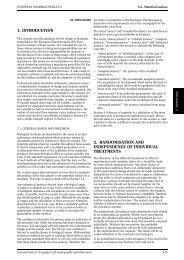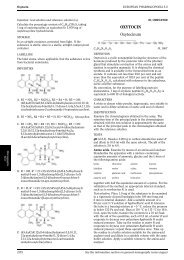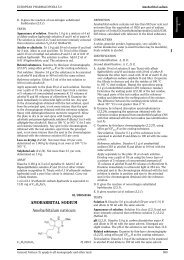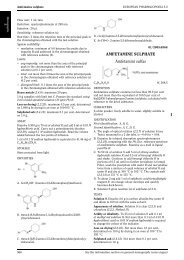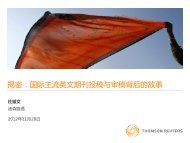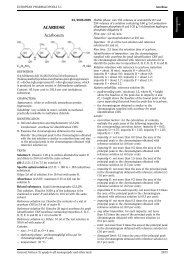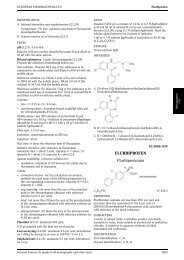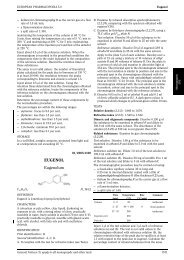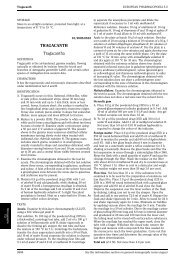EXTRACTS Extracta
EXTRACTS Extracta
EXTRACTS Extracta
You also want an ePaper? Increase the reach of your titles
YUMPU automatically turns print PDFs into web optimized ePapers that Google loves.
Extracts EUROPEAN PHARMACOPOEIA 5.0<br />
Where possible, the biological potency of the IHRP is<br />
established by in vivo techniques such as skin testing,<br />
and expressed in units of biological activity. If not, for<br />
certain extracts, potency may be established by suitable<br />
immunoassays (for example, those based on the inhibition<br />
of the binding capacity of specific immunoglobulin E<br />
antibodies) or by quantitative techniques for a single major<br />
component.<br />
IDENTIFICATION<br />
Identity is confirmed at the intermediate or other applicable<br />
stage by comparison with the IHRP using protein profiling<br />
by appropriate methods (for example, isoelectric focusing,<br />
sodium dodecyl sulphate-polyacrylamide gel electrophoresis<br />
or immunoelectrophoresis).<br />
TESTS<br />
Various biochemical and immunological tests have been<br />
developed in order to characterise allergens qualitatively<br />
and quantitatively. However, some of the methods,<br />
particularly for the determination of allergenic activity<br />
and allergen profile, are not applicable to all products<br />
at present. This is because knowledge of the allergenic<br />
components or the required reagents is not available.<br />
Accordingly, allergen products have been classified in<br />
different categories with increasing test requirements,<br />
accordingtoqualityandintendeduse.<br />
Wherepossiblethefollowingtestsareappliedtothe<br />
final preparations. If not, they must be performed on the<br />
extracts as late as possible in the manufacturing process,<br />
for example, at the stage immediately prior to that stage<br />
(modification, dilution etc.) which renders the test not<br />
feasible on the final preparation.<br />
Water (2.5.12).Notmorethan5percentforfreeze-dried<br />
products.<br />
Sterility (2.6.1). Allergen products intended for parenteral,<br />
bronchial and conjunctival administration comply with the<br />
test for sterility.<br />
Protein content: 80percentto120percentofthestated<br />
content of a given batch. If the biological potency can be<br />
determined then the test for protein content may be omitted.<br />
Protein profile. The protein composition determined by<br />
suitable methods corresponds to that of the IHRP.<br />
Abnormal toxicity (2.6.9). Allergen products obtained from<br />
moulds and intended for parenteral administration (except<br />
skin-prick tests) comply with the test for abnormal toxicity<br />
for immunosera and vaccines for human use.<br />
Various additional tests, somewith increasing selectivity,<br />
depending on the allergen product concerned can be<br />
applied, but in any case for allergen products intended for<br />
therapeutic use a validated test measuring the potency<br />
(total allergenic activity, determination of individual<br />
allergens or any other justified tests) must be applied.<br />
Aluminium (2.5.13). Not less than 80 per cent and not more<br />
than 120 per cent of the stated amount but in any case<br />
notmorethan1.25mgperhumandoseunlessotherwise<br />
justified and authorised, when aluminium hydroxide or<br />
aluminium phosphate is used as adsorbent.<br />
Calcium (2.5.14). Not less than 80 per cent and not more<br />
than 120 per cent of the stated amount when calcium<br />
phosphateisusedasadsorbent.<br />
Antigen profile. The antigens are identified by means of<br />
suitable techniques using antigen-specific animal antibodies.<br />
Allergen profile. Relevant allergenic components<br />
are identified by means of suitable techniques using<br />
allergen-specific human antibodies.<br />
Total allergenic activity. The activity is 50 per cent to<br />
200 per cent of the stated amount as assayed by inhibition of<br />
the binding capacity of specific immunoglobulin E antibodies<br />
or a suitable equivalent in vitro method.<br />
Individual allergens: 50 per cent to 200 per cent of the<br />
stated amount, determined by a suitable method.<br />
STORAGE<br />
Adsorbed allergen products should not be frozen.<br />
LABELLING<br />
The label states:<br />
— the biological potency and/or the protein content and/or<br />
the extraction concentration;<br />
— the route of administration and the intended use;<br />
— the storage conditions;<br />
— where applicable, the name and amount of added<br />
antimicrobial preservative;<br />
— for freeze-dried preparations:<br />
— the name, composition and volume of the<br />
reconstituting liquid to be added<br />
— the period of time within which the preparation is to<br />
be used after reconstitution;<br />
— where applicable, that the preparation is sterile;<br />
— where applicable the name and amount of adsorbent.<br />
<strong>EXTRACTS</strong><br />
<strong>Extracta</strong><br />
01/2005:0765<br />
DEFINITION<br />
Extracts are preparations of liquid (liquid extracts and<br />
tinctures), semi-solid (soft extracts) or solid (dry extracts)<br />
consistency, obtained from herbal drugs or animal matters,<br />
which are usually in a dry state.<br />
Different types of extract may be distinguished. Standardised<br />
extracts are adjusted within an acceptable tolerance to<br />
a given content of constituents with known therapeutic<br />
activity; standardisation is achieved by adjustment of<br />
the extract with inert material or by blending batches of<br />
extracts. Quantified extracts are adjusted to a defined range<br />
of constituents; adjustments are made by blending batches<br />
of extracts. Other extracts are essentially defined by their<br />
production process (state of the herbal drug or animal<br />
matter to be extracted, solvent, extraction conditions) and<br />
their specifications.<br />
PRODUCTION<br />
Extracts are prepared by suitable methods using ethanol or<br />
other suitable solvents. Different batches of the herbal drug<br />
or animal matter may be blended prior to extraction. The<br />
herbal drug or animal matter to be extracted may undergo a<br />
preliminary treatment, for example, inactivation of enzymes,<br />
grinding or defatting. In addition, unwanted matter may be<br />
removed after extraction.<br />
Herbal drugs, animal matters and organic solvents used<br />
for the preparation of extracts comply with any relevant<br />
monograph of the Pharmacopoeia. For soft and dry extracts<br />
where the organic solvent is removed by evaporation,<br />
recoveredorrecycledsolventmaybeused,providedthatthe<br />
recovery procedures are controlled and monitored to ensure<br />
that solvents meet appropriate standards before re-use or<br />
admixture with other approved materials. Water used for<br />
the preparation of extracts is of suitable quality. Except<br />
for the test for bacterial endotoxins, water complying with<br />
570 See the information section on general monographs (cover pages)
EUROPEAN PHARMACOPOEIA 5.0 Extracts<br />
the section on Purified water in bulk of the monograph on<br />
Purified water (0008) is suitable. Potable water may be<br />
suitable if it complies with a defined specification that allows<br />
the consistent production of a suitable extract.<br />
Where applicable, concentration to the intended consistency<br />
is carried out using suitable methods, usually under reduced<br />
pressure, and at a temperature at which deterioration of the<br />
constituents is reduced to a minimum. Essential oils that<br />
have been separated during processing may be restored to<br />
the extracts at an appropriate stage in the manufacturing<br />
process. Suitable excipients may be added at the various<br />
stages of the manufacturing process for example to improve<br />
technological qualities such as homogeneity or consistency.<br />
Suitable stabilisers and antimicrobial preservatives may also<br />
be added.<br />
Extraction with a given solvent leads to typical proportions<br />
of characterised constituents in the extractable matter;<br />
during production of standardised and quantified extracts,<br />
purification procedures may be applied that increase these<br />
proportions with respect to the expected values; such<br />
extracts are referred to as “refined”.<br />
IDENTIFICATION<br />
Extracts are identified using a suitable method.<br />
TESTS<br />
Where applicable, as a result of analysis of the herbal drug<br />
or animal matter used for production and in view of the<br />
production process, tests for microbiological quality (5.1.4),<br />
heavy metals, aflatoxins, pesticide residues (2.8.13) inthe<br />
extracts may be necessary.<br />
ASSAY<br />
Wherever possible, extracts are assayed by a suitable method.<br />
LABELLING<br />
The label states:<br />
— the herbal drug or animal matter used,<br />
— whether the extract is liquid, soft or dry, or whether it<br />
is a tincture,<br />
— for standardised extracts, the content of constituents with<br />
known therapeutic activity,<br />
— for quantified extracts, the content of constituents<br />
(markers) used for quantification,<br />
— the ratio of the starting material to the genuine extract<br />
(DER),<br />
— the solvent or solvents used for extraction,<br />
— where applicable, that a fresh herbal drug or fresh animal<br />
matter has been used,<br />
— where applicable, that the extract is “refined”,<br />
— the name and amount of any excipient used including<br />
stabilisers and antimicrobial preservatives,<br />
— where applicable, the percentage of dry residue.<br />
Liquid extracts — extracta fluida<br />
DEFINITION<br />
Liquid extracts are liquid preparations of which, in general,<br />
1 part by mass or volume is equivalent to 1 part by mass of the<br />
dried herbal drug or animal matter. These preparations are<br />
adjusted, if necessary, so that they satisfy the requirements<br />
for content of solvent, and, where applicable, for constituents.<br />
PRODUCTION<br />
Liquid extracts are prepared by using ethanol of suitable<br />
concentration or water to extract the herbal drug or animal<br />
matter, or by dissolving a soft or dry extract (which has been<br />
produced using the same strength of extraction solvent as<br />
is used in preparing the liquid extract by direct extraction)<br />
of the herbal drug or animal matter in either ethanol of<br />
suitable concentration or water. Liquid extracts may be<br />
filtered, if necessary.<br />
Aslightsedimentmayformonstanding,whichisacceptable<br />
as long as the composition of the liquid extract is not<br />
changed significantly.<br />
TESTS<br />
Relative density (2.2.5). Where applicable, the liquid extract<br />
complies with the limits prescribed in the monograph.<br />
Ethanol (2.9.10). For alcoholic liquid extracts, carry out<br />
the determination of ethanol content. The ethanol content<br />
complies with that prescribed.<br />
Methanol and 2-propanol (2.9.11): maximum 0.05 per<br />
cent V/V of methanol and maximum 0.05 per cent V/V of<br />
2-propanol for alcoholic liquid extracts unless otherwise<br />
prescribed.<br />
Dry residue (2.8.16). Where applicable, the liquid extract<br />
complies with the limits prescribed in the monograph,<br />
corrected if necessary, taking into account any excipient<br />
used.<br />
STORAGE<br />
Protected from light.<br />
LABELLING<br />
The label states in addition to the requirements listed above:<br />
— where applicable, the ethanol content in per cent V/V in<br />
the final extract.<br />
Tinctures — tincturae<br />
DEFINITION<br />
Tinctures are liquid preparations which are usually obtained<br />
using either 1 part of herbal drug or animal matter and<br />
10 parts of extraction solvent or 1 part of herbal drug or<br />
animal matter and 5 parts of extraction solvent.<br />
PRODUCTION<br />
Tinctures are prepared by maceration or percolation (outline<br />
methodology is given below) using only ethanol of a suitable<br />
concentration for extraction of the herbal drug or animal<br />
matter, or by dissolving a soft or dry extract (which has been<br />
produced using the same strength of extraction solvent as<br />
is used in preparing the tincture by direct extraction) of<br />
the herbal drug or animal matter in ethanol of a suitable<br />
concentration. Tinctures are filtered, if necessary.<br />
Tinctures are usually clear. A slight sediment may form on<br />
standing which is acceptable as long as the composition of<br />
the tincture is not changed significantly.<br />
Production by maceration. Unless otherwise prescribed,<br />
reduce the herbal drug or animal matter to be extracted to<br />
pieces of suitable size, mix thoroughly with the prescribed<br />
extraction solvent and allow to stand in a closed container<br />
for an appropriate time. The residue is separated from the<br />
extraction solvent and, if necessary, pressed out. In the latter<br />
case, the 2 liquids obtained are combined.<br />
Production by percolation. If necessary, reduce the herbal<br />
drug or animal matter to be extracted to pieces of suitable<br />
size. Mix thoroughly with a portion of the prescribed<br />
extraction solvent and allow to stand for an appropriate time.<br />
Transfer to a percolator and allow the percolate to flow at<br />
room temperature slowly making sure that the herbal drug<br />
GeneralNotices(1)applytoallmonographsandothertexts 571
Herbal drug preparations EUROPEAN PHARMACOPOEIA 5.0<br />
or animal matter to be extracted is always covered with the<br />
remaining extraction solvent. The residue may be pressed<br />
outandtheexpressedliquidcombinedwiththepercolate.<br />
TESTS<br />
Relative density (2.2.5). Where applicable, the tincture<br />
complies with the limits prescribed in the monograph.<br />
Ethanol (2.9.10). The ethanol content complies with that<br />
prescribed.<br />
Methanol and 2-propanol (2.9.11): maximum0.05per cent V/V of methanol and maximum 0.05 per cent V/V of<br />
2-propanol, unless otherwise prescribed.<br />
Dry residue (2.8.16).Whereapplicable,thetincturecomplies<br />
with the limits prescribed in the monograph, corrected if<br />
necessary, taking into account any excipient used.<br />
STORAGE<br />
Protected from light.<br />
LABELLING<br />
The label states in addition to the requirements listed above:<br />
— for tinctures other than standardised and quantified<br />
tinctures, the ratio of starting material to extraction liquid<br />
or of starting material to final tincture,<br />
— the ethanol content in per cent V/V in the final tincture.<br />
Soft extracts — extracta spissa<br />
DEFINITION<br />
Soft extracts are semi-solid preparations obtained by<br />
evaporation or partial evaporation of the solvent used for<br />
extraction.<br />
TESTS<br />
Dry residue (2.8.16). The soft extract complies with the<br />
limits prescribed in the monograph.<br />
Solvents. Where applicable, a monograph on a soft extract<br />
prescribes a limit test for the solvent used for extraction.<br />
STORAGE<br />
Protected from light.<br />
Dry extracts — extracta sicca<br />
DEFINITION<br />
Dry extracts are solid preparations obtained by evaporation<br />
of the solvent used for their production. Dry extracts usually<br />
havealossondryingorawatercontentofnotgreaterthan<br />
5percentm/m.<br />
TESTS<br />
Water (2.2.13). Where applicable, the dry extract complies<br />
with the limits prescribed in the monograph.<br />
Loss on drying (2.8.17). Where applicable, the dry extract<br />
complies with the limits prescribed in the monograph.<br />
Solvents. Where applicable, a monograph on a dry extract<br />
prescribes a limit test for the solvent used for extraction.<br />
STORAGE<br />
In an airtight container, protected from light.<br />
01/2005:1434<br />
HERBAL DRUG PREPARATIONS<br />
Plantae medicinales praeparatore<br />
DEFINITION<br />
Herbal drug preparations are obtained by subjecting<br />
herbaldrugstotreatmentssuchasextraction,distillation,<br />
expression, fractionation, purification, concentration or<br />
fermentation. These include comminuted or powdered<br />
herbal drugs, tinctures, extracts, essential oils, expressed<br />
juices and processed exudates.<br />
Herbal teas comply with the monograph on Herbal<br />
teas (1435).<br />
Instant herbal teas consist of powder or granules of one or<br />
more herbal drug preparation(s) intended for the preparation<br />
of an oral solution immediately before use.<br />
HERBAL DRUGS<br />
Plantae medicinales<br />
01/2005:1433<br />
DEFINITION<br />
Herbal drugs are mainly whole, fragmented or cut, plants,<br />
parts of plants, algae, fungi, lichen in an unprocessed state,<br />
usually in dried form but sometimes fresh. Certain exudates<br />
that have not been subjected to a specific treatment are also<br />
considered to be herbal drugs. Herbal drugs are precisely<br />
defined by the botanical scientific name according to the<br />
binominal system (genus, species, variety and author).<br />
PRODUCTION<br />
Herbal drugs are obtained from cultivated or wild plants.<br />
Suitable collection, cultivation, harvesting, drying,<br />
fragmentation and storage conditions are essential to<br />
guarantee the quality of herbal drugs.<br />
Herbal drugs are, as far as possible, free from impurities such<br />
as soil, dust, dirt and other contaminants such as fungal,<br />
insect and other animal contaminations. They are not rotten.<br />
If a decontaminating treatment has been used, it is necessary<br />
to demonstrate that the constituents of the plant are not<br />
affected and that no harmful residues remain. The use of<br />
ethylene oxide is prohibited for the decontamination of<br />
herbal drugs.<br />
IDENTIFICATION<br />
Herbal drugs are identified using their macroscopic and<br />
microscopic descriptions and any further tests that may be<br />
required (for example, thin-layer chromatography).<br />
TESTS<br />
Atestforforeignmatter(2.8.2) iscarriedout,unless<br />
otherwise prescribed in the individual monographs.<br />
A specific appropriate test may apply to herbal drugs liable<br />
to be falsified.<br />
If appropriate, the herbal drugs comply with other tests, for<br />
example, total ash (2.4.16), ash insoluble in hydrochloric<br />
acid (2.8.1), extractable matter, swelling index (2.8.4) and<br />
bitterness value.<br />
The test for loss on drying (2.2.32) iscarriedouton<br />
herbal drugs, unless otherwise prescribed in the individual<br />
monographs. A determination of water (2.2.13) iscarried<br />
out for herbal drugs with a high essential oil content.<br />
572 See the information section on general monographs (cover pages)



